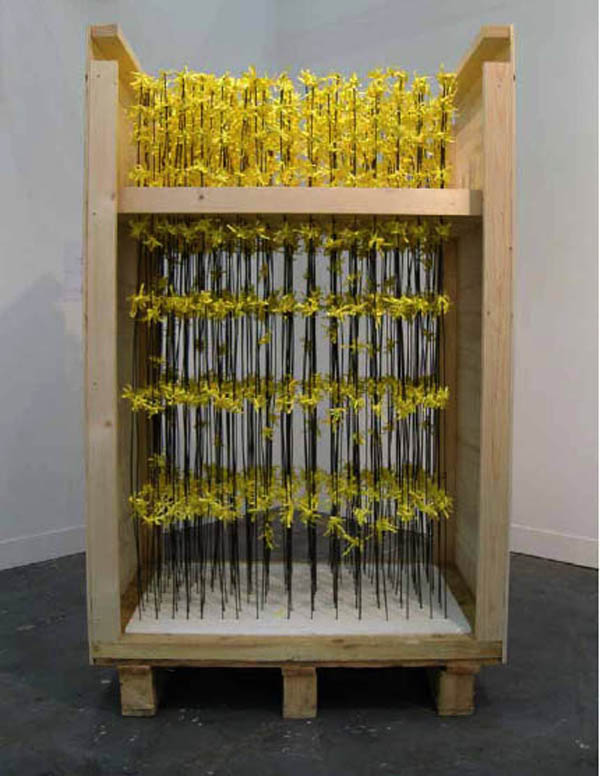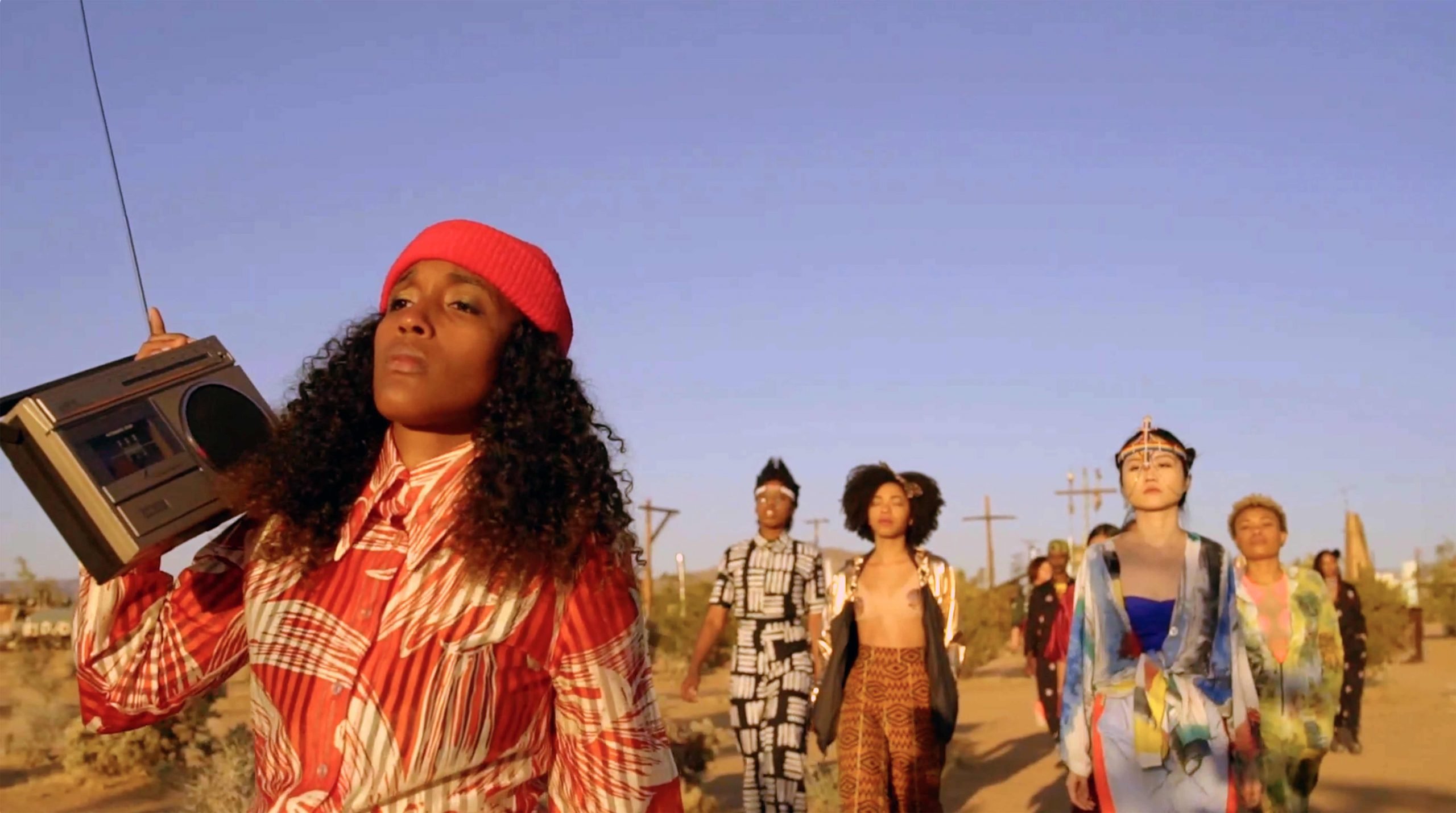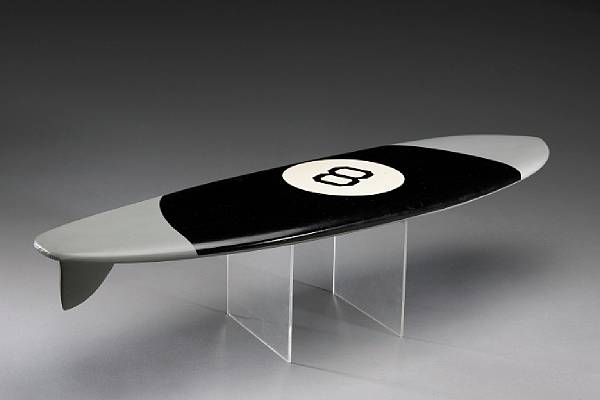
© » KADIST
Joe Namy
Joe Namy’s Half Blue is an installation consisting of a video, a sound, and a sculpture, that triangulates a personal experience of the artist’s cousin Khalid Jabara, who was murdered by hate crime in Tulsa, Oklahoma, U. S. A in 2016. An event that garnered international attention, Jabara’s murder led to the Jabara-Heyer NO HATE Act passed by US Congress in 2021. The act was named after Jabara and Heather Heyer, two hate crime victims whose murders were prosecuted as hate crimes but not reported in hate crime statistics.

© » KADIST
Joe Scanlan
Spring Line is a piece shown for the first time in his solo exhibition at the Institut d’Art Contemporain in Villeurbanne in 2007. It pays homage to the work of the famous conceptual artist Sol LeWitt, who had died on 8 April that year. Scanlan aims to guide the spectator to gage the level of influence Sol LeWitt has had on his work with regards the conversion of potential ideas into sculpture.

© » KADIST
Joe Biel
Drawing & Print (Drawing & Print)
Head in Hands by Joe Biel is part of a larger series of drawings made in connection with the book of short stories Navigating Ghosts by Annie Buckley. Biel’s small-scale black and white drawing features a torso holding their own head in their hands, though the expression on the bodiless face maintains a serene sensibility. The edges of the drawing around the figure’s neck and torso are softened so that the figure appears ghostly, as if the character is an illusion or dream.

© » KADIST
Alicia Smith
The title of Alicia Smith’s video work, Teomama , means “God Carrier” in the Aztec language of Nahuatl. It was the name given to medicine men and women who carried the bones of Huitzilopochtli—the god of war, sun, and human sacrifice in ancient Mexico, and the national deity of the Aztecs. Of the many legends featuring Huitzilopochtli, the origin story of Tenochtitlan (present day Mexico City) is perhaps one of the most well-known.

© » KADIST
Alexis Smith
Iron Sorrows (1990) brings together what are for Alexis Smith common motifs and materials such as scavenged and repurposed metal, and street signage. Iron is one of nature’s most abundant metals. Smith, a philosopher of human detritus and poetic associations, presents it in this work as simultaneously everywhere yet paradoxically forgotten, lost in the heaps of refuse that fill junkyards and vacant lots.

© » KADIST
Cauleen Smith
Set to the iconic and spiritual music of Alice Coltrane’s Turiyasangitananda (1937–2007), Cauleen Smith’s film Sojourner travels across the US to visit a series of sites important to an alternative and creative narrative of black history. While the approach may appear spiritual, it is more futuristic (Afrofuturism and Radical Jazz) than religious. Smith is interested in using the individual stories of “those who have formed their own solutions” as a reconstructive and healing lens for considering the past.

© » KADIST
Alexis Smith
In 8 Ball Surfboard (1995),Alexis Smith combines her long-term interests in California culture and conceptual assemblage. The surfboard, an emblem of Southern California, emblazoned with the image of an eight-ball, references numerous tropes and clichés of American popular culture, specifically subcultures related to pool halls, surfing, and beaches. Indeed, this model-scale surfboard may be a future pop-culture relic, referencing a particular surfer or era of board design.

© » KADIST
Sable Elyse Smith
Sable Elyse Smith’s Pivot III resembles playground equipment uselessly reconfigured. The stainless-steel asterisks, assembled from prison visitation-room seating, are painted 2K black and blue: colors evoking the US criminal justice system, its racist enforcement, and the heavy-duty finish of finance capitalism with which the culture industry is enmeshed. The work consists of six long rods, affixed via plate to each of the faces of a central cube, from which they radiate in perfect symmetry.

© » KADIST
Wadada Leo Smith
Drawing & Print (Drawing & Print)
Kosmic Music is a musical score comprised of two parts: a single mixed media drawing titled Colors and Satellites, and a pair of mixed media drawings titled Koral Reef . Conceived of together as a single musical score, the three drawings exemplify a specific stage in the evolution of Wadada Leo Smith’s Ankhrasmation Language, which he has been developing since 1967. Although at first glance the works in Kosmic Music might appear abstract compositions drawn on paper, as with other scores produced by Smith, suggestions of musical structures are revealed upon closer inspection: an entanglement of musical sheets and bright geometric forms.
Alexis Smith
- location: Los Angeles, California
- year born: 1949
- gender: female
- nationality: American
- home town: Los Angeles, California
Joe Namy
Artist and musician Joe Namy’s practice encompasses sound, its history, and impact on the built environment...
Sable Elyse Smith
Sable Elyse Smith is an interdisciplinary artist, writer, and educator based in New York and Richmond, Virginia...
Alicia Smith
Alicia Smith is a Xicana artist and activist whose work thoughtfully engages with the subjects of indigeneity, colonialism, the environment, and the female body...
Cauleen Smith
Cauleen Smith is an artist and filmmaker whose approach has been shaped by the discourse of mid-twentieth-century experimental film — including structuralism, third world cinema, and science fiction...
Wadada Leo Smith
Wadada Leo Smith is an avant-garde jazz musician, composer, educator and visual artist, celebrated for his creative and unconventional approach to music...
Joe Biel
Working primarily in drawing, Joe Biel is interested in charged human situations...
Joe Scanlan
Joe Scanlan became known in the 1990s due to his very particular appropriation of Conceptual art, exploiting two main registers: display on one hand, designating the artwork as a consumable product, DIY on the other, advocating the mobility and adaptability of objects, even their reversibility depending on contexts and usages...
-
1990-1999
Alexis Smith
1990Iron Sorrows (1990) brings together what are for Alexis Smith common motifs and materials such as scavenged and repurposed metal, and street signage...
Alexis Smith
1995In 8 Ball Surfboard (1995),Alexis Smith combines her long-term interests in California culture and conceptual assemblage...
-
2000-2009
Joe Scanlan
2007Spring Line is a piece shown for the first time in his solo exhibition at the Institut d’Art Contemporain in Villeurbanne in 2007...
Joe Biel
Drawing & Print
2007(Drawing & Print) Head in Hands by Joe Biel is part of a larger series of drawings made in connection with the book of short stories Navigating Ghosts by Annie Buckley...
-
2010-2019
Alicia Smith
2018The title of Alicia Smith’s video work, Teomama , means “God Carrier” in the Aztec language of Nahuatl...
Cauleen Smith
2018Set to the iconic and spiritual music of Alice Coltrane’s Turiyasangitananda (1937–2007), Cauleen Smith’s film Sojourner travels across the US to visit a series of sites important to an alternative and creative narrative of black history...
-
2020-2029
Sable Elyse Smith
2020Sable Elyse Smith’s Pivot III resembles playground equipment uselessly reconfigured...
